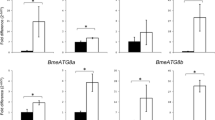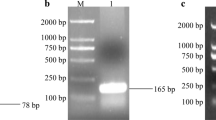Abstract
Rhipicephalus microplus is a hematophagous ectoparasite that significantly affects parasitized cattle. As a one-host tick its entire life cycle consists of free-living and parasitic forms. Its extraordinary ability to survive during prolonged off-host periods has been related to the process of cytoplasmic degradation called autophagy. In order to deepen our understanding of this process during R. microplus non-parasitic stages, we determined the expression dynamics of a set of five autophagy-related genes (ATG genes) during embryonic development and over an increasing larval starvation period of 50 days. We found two apparent successive waves of ATG genes transcriptional activation, which paralleled key embryonic changes such as cellularization and organogenesis, as well as nutrient utilization. Moreover, during increasing larval starvation, ATG genes were up-regulated cyclically every 10–15 days. Taken together, our results suggest that autophagy is playing a major role in embryo development and energy metabolism during starvation in R. microplus.


Similar content being viewed by others
References
Andersen CL, Jensen JL, Ørntoft TF (2004) Normalization of real-time quantitative reverse transcription-PCR data: a model-based variance estimation approach to identify genes suited for normalization, applied to bladder and colon cancer data sets. Cancer Res 64:5245–5250
Bolliet V, Labonne J, Olazcuaga L, Panserat S, Seiliez I (2017) Modeling of autophagy-related gene expression dynamics during long term fasting in European eel (Anguilla anguilla). Sci Rep 7:17896
Campos E, Moraes J, Façanha AR, Moreira É, Valle D, Abreu L, Manso PPA, Nascimento A, Pelajo-Machado M, Lenzi H, Masuda A, da Silva IV Jr., Logullo C (2006) Kinetics of energy source utilization in Boophilus microplus (Canestrini, 1887) (Acari: Ixodidae) embryonic development. Vet Parasitol 138:349–357
Davey RB, Garza J Jr, Thompson GD, Drummond RO (1980) Ovipositional biology of the southern cattle tick, Boophilus microplus (Acari: Ixodidae), in the laboratory. J Med Entomol 17(2):117–121
Deretic V, Saitoh T, Akira S (2013) Autophagy in infection, inflammation and immunity. Nat Rev Immunol 13:722–737
Flores FJM, Gutiérrez OA, Rosario CR, Padilla CE, Álvarez AH, Martínez VM (2014) Molecular cloning and characterization of two novel autophagy-related genes belonging to the ATG8 family from the cattle tick Rhipicephalus (Boophilus) microplus (Acari: Ixodidae). Exp Appl Acarol 64(4):533–542
Flores FJM, Barragán ACP, Sánchez HCV, Padilla CE, González CC, Ortuño SD, Martínez VM (2016) Molecular characterization and expression analysis of three novel autophagy-related genes from the cattle tick Rhipicephalus (Boophilus) microplus (Acari: Ixodidae). Parasitology 143:1802–1809
Hitchcock LF (1955) Studies of the non-parasitic stages on the cattle tick, Boophilus microplus (Canestrini) (Acarina: Ixodidae). Aust J Zool 3(2):145–155
Huerta-Cepas J, Serra F, Bork P (2016) ETE 3: reconstruction, analysis, and visualization of phylogenomic data. Mol Biol Evol 33:1635–1638
Kuhn H, Sopko R, Coughlin M, Perrimon N, Mitchinson T (2015) The Atg1-Tor pathway regulates yolk catabolism in Drosophila embryos. Development 142:3869–3878
Liu Y, Zou W, Yang P, Wang L, Ma Y, Zhang H, Wang X (2018) Autophagy-dependent ribosomal RNA degradation is essential for maintaining nucleotide homeostasis during C. elegans development. eLife 7:e36588
Livak KJ, Schmittgen TD (2001) Analysis of relative gene expression data using real-time quantitative PCR and the 2−∆∆CT method. Methods 25:402–408
Logullo C, Moraes J, Dansa-Petretski M, JrIS Vaz, Masuda A, Sorgine MHF, Braz GR, Masuda H, Oliveira PL (2002) Binding and storage of heme by vitellin from the cattle tick, Boophilus microplus. Insect Biochem Mol Biol 32:1805–1811
Miranda-Miranda E, Cossio-Bayugar R, Quezada-Delgado MDR, Olvera-Valencia F, Neri-Orantes S (2009) Age-induced carboxylesterase expression in acaricide-resistant Rhipicephalus microplus. Res J Parasitol 4(3):70–78
Mulakkal NC, Nagy P, Takats S, Tusco R, Juhász G, Nezis IP (2014) Autophagy in Drosophila: from historical studies to current knowledge. BioMed Res Int. https://doi.org/10.1155/2014/273473
Nijhof AM, Balk JA, Postigo M, Jongejan F (2009) Selection of reference genes for quantitative RT-PCR studies in Rhipicephalus (Boophilus) microplus and Rhipicephalus appendiculatus ticks and determination of the expression profile of Bm86. BMC Mol Biol 10:112
Nuñez JL, Muñoz-Cobeñas ME, Moltedo HL (1985) Boophilus microplus. The common cattle tick. Springer, Berlin, p 204
Rosendale AJ, Dunlevy ME, McCue MD, Benoit JB (2019) Progressive behavioural, physiological and transcriptomic shifts over the course of prolonged starvation in ticks. Mol Ecol 28:49–65
Santos VT, Ribeiro L, Fraga A, de Barros CM, Campos E, Moraes J, Fontenele MR, Araújo HM, Feitosa NM, Logullo C, da Fonseca RN (2013) The embryogenesis of the tick Rhipicephalus (Boophilus) microplus: the establishment of a new chelicerate model system. Genesis 51:803–818
Senbill H, Hazarika LK, Baruah A, Borah DK, Bhattacharyya B, Rahman S (2018) Life cycle of the southern cattle tick, Rhipicephalus (Boophilus) microplus Canestrini 1888 (Acari: Ixodidae) under laboratory conditions. Syst Appl Acarol 23(6):1169–1179
Stamatakis A (2014) RAxML version 8: a tool for phylogenetic analysis and post-analysis of large phylogenies. Bioinformatics 30:1312–1313
Umemiya-Shirafuji R, Galay RL, Maeda H, Kawano S, Tanaka T, Fukumoto S, Suzuki H, Tsuji N, Fujisaki K (2014) Expression analysis of autophagy-related genes in the hard tick Haemaphysalis longicornis. Vet Parasitol 201:169–175
Untergasser A, Cutcutache I, Koressaar T, Ye J, Faircloth BC, Remm M, Rozen SG (2012) Primer3-new capabilities and interfaces. Nucleic Acids Res 40(15):e115
Zhao Y, Tian E, Zhang H (2009) Selective autophagic degradation of maternally-loaded germline P granule components in somatic cells during C. elegans embryogenesis. Autophagy 5(5):717–719
Acknowledgements
This work was supported by Consejo Nacional de Ciencia y Tecnología (CONACYT) México; Grant Numbers 216321 and 246310, both to MMV.
Author information
Authors and Affiliations
Corresponding author
Additional information
Publisher's Note
Springer Nature remains neutral with regard to jurisdictional claims in published maps and institutional affiliations.
Rights and permissions
About this article
Cite this article
González Castillo, C., Ortuño Sahagún, D. & Martínez Velázquez, M. Expression dynamics of autophagy-related genes in the cattle tick Rhipicephalus microplus during embryonic development and under increasing larval starvation. Exp Appl Acarol 79, 255–266 (2019). https://doi.org/10.1007/s10493-019-00428-7
Received:
Accepted:
Published:
Issue Date:
DOI: https://doi.org/10.1007/s10493-019-00428-7




